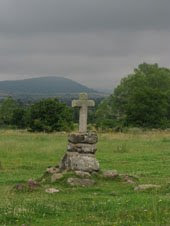Cut logs are stacked on the back of a lorry in a lay-by on Sunday night, waiting to be hauled to a 
The last week of our walk, partly no doubt because our minds are tending that way, has offered us sights and smells that link back to so many moments in the past nine months. As my breath forms clouds around me, wrapped up in layers as we set out with the late-rising sun, the certainty of a warm and sparkling afternoon carries us back to the magical days of the Pays de Bray in February. Then, we rejoiced at 16°C afternoons. Now, we luxuriate in 28°C.
The acorns we saw sprouting red in the dark earth of February and March have reappeared on the trees and now are falling again to lie freshly at our feet, where carpets of autumn crocuses have replaced the spring ones we were so excited to see.
A few days ago in the last real vineyards of the trip the grapes were black and heavy, still covered in grey bloom as the crates were stacked ready for the harvest. It is surprising to realise how the seasons have passed since we walked through the dead-seeming twigs of the Champagne vineyards or the green but flower-less ones of Chablis.
In a rare excursion into a Spanish bed and breakfast

Echoes of the Auvergne lie in wait in the tiny hamlets behind herd of cows for whom we have to linger patiently for them to return to their fields from milking. Like in the Basque country, the old farmers of Galicia want to stop and chat with us, for the pleasure of meeting strangers. And yet the drinks vending machines and even outdoor internet points outside farmyards make me laugh at my surprise over the vending machine adaptability of France.
There's almost a third spring here in Galicia. In the Auvergne we welcomed foxgloves, honeysuckle and clover that we had last seen around the Lac du Der. But here they are again in late S
The season is definitely cooler. Although the maize is fattening in fields just like under the oppressive heat of the Gers, we've often returned to our cosy way of spending later afternoons and evenings under the blankets on our beds, once the sun has dipped and we're waiting for the dinner hour. No doubt the climate here helps make it feel like home: in the green, wooded hill we walk along sandy tacks under trees, between centuries-old stone walls, and spontaneously remember the lanes of the North Downs Way.
Other things are very different but still recall the year. Where French villages are so often devoid of their cafes, Spanish villa


29th September 2008
Monday, 29 September 2008
The cycle of the seasons
Posted by
Rachel Escott
at
16:27
![]()








































































1 comment:
Almost there - amazing achievement. So now you know the way, any thoughts about the return leg?
Post a Comment